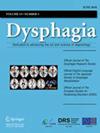求助PDF
{"title":"急诊科非临床研究人员进行吞咽困难筛查的准确性。","authors":"Ryan J Burdick, Nicole Rogus-Pulia, Rebecca Schwei, Sara Gustafson, Raele Donetha Robison, Rosemary Martino, Michael Pulia","doi":"10.1007/s00455-024-10710-5","DOIUrl":null,"url":null,"abstract":"<p><p>Although the emergency department (ED) is the initial care setting for the majority of older adults requiring hospital admission, there is a paucity of ED-based dysphagia research in this at-risk population. This is driven by barriers to dysphagia evaluation in this complex care environment. Therefore, we assessed the reliability of trained, non-clinical ED research staff in administering dysphagia screening tools compared to trained speech pathologists (SLPs). We also aimed to determine perceptual screening discrepancies (e.g. voice change) between clinical and non-clinical staff. Forty-two older adults with suspected pneumonia were recruited during an ED visit and underwent dysphagia (Toronto Bedside Swallow Screening Tool; TOR-BSST©) and aspiration (3-oz water swallow test; 3-oz WST) screening by trained non-clinical research staff. Audio-recordings of screenings were re-rated post-hoc by trained, blinded SLPs with discrepancies resolved via consensus. Cohen's kappa (unweighted) revealed moderate agreement in pass/fail ratings between clinical and non-clinical staff for both the TOR-BSST© (k = 0.75) and the 3 oz WST (k = 0.66) corresponding to excellent sensitivity and good specificity for both the TOR-BSST (SN = 94%, SP = 85%) and the 3 oz WST (SN = 90%, SP = 81%). Further analysis of TOR-BSST perceptual parameters revealed that most discrepancies between clinicians and non-clinicians resulted from over-diagnosis of change in vocal quality (53%). These results support the feasibility of non-clinical research staff administering screening tools for dysphagia and aspiration in the ED. Dysphagia screening may not necessitate clinical staff involvement, which may improve feasibility of large-scale ED research. Future training of research staff should focus on perceptual assessment of vocal quality.</p>","PeriodicalId":11508,"journal":{"name":"Dysphagia","volume":" ","pages":"132-140"},"PeriodicalIF":2.2000,"publicationDate":"2025-02-01","publicationTypes":"Journal Article","fieldsOfStudy":null,"isOpenAccess":false,"openAccessPdf":"","citationCount":"0","resultStr":"{\"title\":\"Accuracy of Dysphagia Screening by Non-clinical Research Staff in the Emergency Department.\",\"authors\":\"Ryan J Burdick, Nicole Rogus-Pulia, Rebecca Schwei, Sara Gustafson, Raele Donetha Robison, Rosemary Martino, Michael Pulia\",\"doi\":\"10.1007/s00455-024-10710-5\",\"DOIUrl\":null,\"url\":null,\"abstract\":\"<p><p>Although the emergency department (ED) is the initial care setting for the majority of older adults requiring hospital admission, there is a paucity of ED-based dysphagia research in this at-risk population. This is driven by barriers to dysphagia evaluation in this complex care environment. Therefore, we assessed the reliability of trained, non-clinical ED research staff in administering dysphagia screening tools compared to trained speech pathologists (SLPs). We also aimed to determine perceptual screening discrepancies (e.g. voice change) between clinical and non-clinical staff. Forty-two older adults with suspected pneumonia were recruited during an ED visit and underwent dysphagia (Toronto Bedside Swallow Screening Tool; TOR-BSST©) and aspiration (3-oz water swallow test; 3-oz WST) screening by trained non-clinical research staff. Audio-recordings of screenings were re-rated post-hoc by trained, blinded SLPs with discrepancies resolved via consensus. Cohen's kappa (unweighted) revealed moderate agreement in pass/fail ratings between clinical and non-clinical staff for both the TOR-BSST© (k = 0.75) and the 3 oz WST (k = 0.66) corresponding to excellent sensitivity and good specificity for both the TOR-BSST (SN = 94%, SP = 85%) and the 3 oz WST (SN = 90%, SP = 81%). Further analysis of TOR-BSST perceptual parameters revealed that most discrepancies between clinicians and non-clinicians resulted from over-diagnosis of change in vocal quality (53%). These results support the feasibility of non-clinical research staff administering screening tools for dysphagia and aspiration in the ED. Dysphagia screening may not necessitate clinical staff involvement, which may improve feasibility of large-scale ED research. Future training of research staff should focus on perceptual assessment of vocal quality.</p>\",\"PeriodicalId\":11508,\"journal\":{\"name\":\"Dysphagia\",\"volume\":\" \",\"pages\":\"132-140\"},\"PeriodicalIF\":2.2000,\"publicationDate\":\"2025-02-01\",\"publicationTypes\":\"Journal Article\",\"fieldsOfStudy\":null,\"isOpenAccess\":false,\"openAccessPdf\":\"\",\"citationCount\":\"0\",\"resultStr\":null,\"platform\":\"Semanticscholar\",\"paperid\":null,\"PeriodicalName\":\"Dysphagia\",\"FirstCategoryId\":\"3\",\"ListUrlMain\":\"https://doi.org/10.1007/s00455-024-10710-5\",\"RegionNum\":3,\"RegionCategory\":\"医学\",\"ArticlePicture\":[],\"TitleCN\":null,\"AbstractTextCN\":null,\"PMCID\":null,\"EPubDate\":\"2024/5/30 0:00:00\",\"PubModel\":\"Epub\",\"JCR\":\"Q1\",\"JCRName\":\"OTORHINOLARYNGOLOGY\",\"Score\":null,\"Total\":0}","platform":"Semanticscholar","paperid":null,"PeriodicalName":"Dysphagia","FirstCategoryId":"3","ListUrlMain":"https://doi.org/10.1007/s00455-024-10710-5","RegionNum":3,"RegionCategory":"医学","ArticlePicture":[],"TitleCN":null,"AbstractTextCN":null,"PMCID":null,"EPubDate":"2024/5/30 0:00:00","PubModel":"Epub","JCR":"Q1","JCRName":"OTORHINOLARYNGOLOGY","Score":null,"Total":0}
引用次数: 0
引用
批量引用



